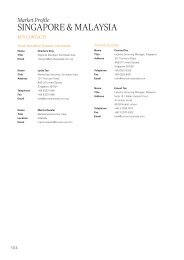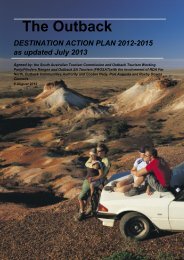Flinders Ranges and Outback Integrated Strategic Tourism Plan
Flinders Ranges and Outback Integrated Strategic Tourism Plan
Flinders Ranges and Outback Integrated Strategic Tourism Plan
You also want an ePaper? Increase the reach of your titles
YUMPU automatically turns print PDFs into web optimized ePapers that Google loves.
Final <strong>Plan</strong><br />
<strong>Plan</strong>ning Policy That Facilitates Sustainable <strong>Tourism</strong> Development<br />
12.0 PLANNING POLICY THAT FACILITATES SUSTAINABLE TOURISM<br />
DEVELOPMENT<br />
12.1 The Role of <strong>Plan</strong>ning Policy<br />
<strong>Plan</strong>ning policy has an important role to play when setting new directions for the tourism<br />
industry. This is due to the likelihood that most tourism operators will, at some point in time,<br />
have to ‘run the gauntlet’ of the planning system <strong>and</strong> submit their plans to either the local<br />
Council or the State Government’s Development Assessment Commission. At this point,<br />
there is a chance that even the most innovative <strong>and</strong> exciting tourism proposal can be<br />
halted in its tracks because it has not been envisaged in the ‘Desired Character Statement’<br />
within the Development <strong>Plan</strong> or is listed as ‘non-complying’ within the zone. Therefore, it is<br />
necessary for planning policy to reflect the latest trends in the tourism industry while also<br />
acknowledging the aspirations of the community for their local area or region.<br />
When developing planning policy, it is critically important that accurate definitions be<br />
developed. The SATC Discussion Paper ‘Sustainable <strong>Tourism</strong> Development in Regional South<br />
Australia’ (2002), supports the introduction of a ‘tourist accommodation’ definition. The term<br />
is already referred to in many Council Development <strong>Plan</strong>s <strong>and</strong> is associated with a diverse<br />
range of accommodation such as nature retreat, hiker’s huts, farm stays or bed <strong>and</strong><br />
breakfast. Tourist accommodation could be defined as a: “Building or group of buildings<br />
providing temporary accommodation for visitors or travellers <strong>and</strong> may include an ancillary<br />
restaurant, office, sales facility, staff accommodation, conference facility <strong>and</strong>/or a<br />
manager’s/caretaker’s residence, but does not include a dwelling, hotel or caravan park”.<br />
This acknowledges that tourism development often needs to be about more than just<br />
accommodation <strong>and</strong> integrate a range of allied activities.<br />
It is equally important for planning policy to provide guidance on the location <strong>and</strong> design of<br />
tourism development. This is especially true for areas of environmental, heritage or cultural<br />
significance – such as the <strong>Flinders</strong> <strong>Ranges</strong> <strong>and</strong> <strong>Outback</strong> areas. Simply put, regions with these<br />
attributes attract tourists <strong>and</strong>, therefore, attract tourism development. However, an<br />
inappropriately located or designed tourism development can have a serious, negative<br />
impact on the attraction <strong>and</strong> quickly result in a decline in the numbers of tourists.<br />
Alternatively, a well-designed <strong>and</strong> sited facility can add value to an attraction, reduce<br />
negative impacts <strong>and</strong> lead to an increase in the number of tourists. It is the role of planning<br />
policy to ensure that this outcome is achieved, supported by competent site analysis <strong>and</strong> an<br />
intelligent design response to issues <strong>and</strong> opportunities.<br />
12.2 The Structure <strong>and</strong> Role of the <strong>Plan</strong>ning System<br />
The State’s <strong>Plan</strong>ning System has three major components – the Development Act <strong>and</strong><br />
associated Regulations; the <strong>Plan</strong>ning Strategy; <strong>and</strong> local Development <strong>Plan</strong>s. The<br />
Development Act provides for the establishment of the <strong>Plan</strong>ning Strategy <strong>and</strong> local<br />
Development <strong>Plan</strong>s. It also provides local Councils <strong>and</strong> the State’s Development Assessment<br />
Urban & Regional <strong>Plan</strong>ning Solutions<br />
d:\frosa region istp\frosa region istp.doc Page 78





